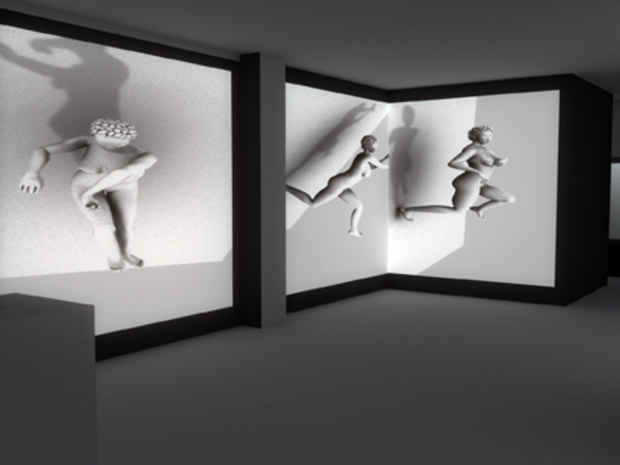Claudia Hart "Recumulations"
Black & White Gallery / Project Space

This event has ended.
Part 1: The Media
Recumulations reconsiders Primary Accumulation (1972), the seminal dance film made by Trisha Brown, in the context of post-analog media. It re-examines possibilities first proposed by Brown in her choreography for a real body recorded by video but now contemporized as a virtual body performing within non-linear digital space as a 3D animated film. It was originally produced for the Black & White Gallery / Project Space, a site-specific not-for-profit art center in Williamsburg, Brooklyn, in dialog and with support from Tatyana Okshteyn, its Founding Director. I'd seen Noemie Lafrance's Melt premiere at Black & White in 2003, and it melded with the Brown work in my conception.
The basis of a Recumulations installation is a performance created while I was a Fellow at the Ellen Stone Belic Institute for the Study of Women and Gender in the Arts and Media in Summer 2010. In collaboration with me, Roberto Sifuentes--a founding member of the performance group La Pocha Nostra--re-performed and then interpreted Brown's Accumulation. Sifuentes' performance was intentionally erratic and spastic, in counter point to Brown's original systematic and intentionally inexpressive sequence of motions.
With support from the Institute, the Sifuentes performance was recorded in the Columbia College motion capture lab for use as raw data for the creation of a new animated choreography. Sifuentes' male and significantly gendered movements will be combined and recombined to form an irrational "rational" system of movement, inserted into a female avatar that I have designed. The result is an animation of a trans-gendered dancer, apparently floating several inches above the walls, compelled by captured motion that accurately expresses gravity yet at the same time uncannily defies it.
The composer Edmund Campion, Professor of Music at the University of California, Berkeley where he also serves as Co-Director at CNMAT (The Center for New Music and AudioTechnologies) has created a malleable digital score for Recumulations. Campion's work proposes a hybrid music, merging digital technologies with more traditional musical forces. Intuitive music fragments and processes (often inspired by physical improvisation) are built into complex digital systems. His compositional strategy strongly reflects that of Hart and Sifuentes. The unique Recumulations music software was created with support from CNMAT and former CNMAT Music Systems Designer, Matthew Wright.
Recumulations builds off of Trisha Brown's early work that so eloquently commented on gravity and on systems and to invert it in relation to our contemporary digital, baroque, and mediated culture.
Recumulations is an individual work of choreography for a prosthetic body. It expresses the fluidities of time and space and the possibility of the transmigration of gender: all significant qualities of the digital realm. Recumulations presents an uneasy realism particularly relevant in our present day culture where the boundary between a representation and reality, and generally between the real and the artificial - is being daily renegotiated.
Part 2: Animation Installation by Hart; Performance by Roberto Sifuentes; Music by Edmund Campion
Recumulations is the basis of a site-specific performance-installation in which the dancing avatar is conceived of as a grotesque architectural element like a virtual caryatid or a gargoyle. The performance object can installed for a single weekend or a single day, and is modular and systematic in a fluid and flexible way. It can be adapted to any location in time or space.
Recumulations projections are off-set and projected floor to ceiling. There can be be 2-8 projections depending on the space. Locations are be determined in relation to columns and structural elements on site. Sifuentes mirrors and responds to his own motion-captured performance that I have in turn modified and have used as the basis of an animated dance.
Sifuentes will perform in a non-structural niche built from wallboard. He will either be seated on a small stool, anchored to the actual ground plane of the gallery, giving him the impression of floating, or will stand on a platform also on long legs, connected to the ground. Non-bearing walls connected to non-bearing studs will be constructed to give the impression of an inset architectural niche.
Duration: 1 hour - 30 minutes to 2 hours
Part 3: Interpretation
Twenty-five years ago, as a young artist, I was inspired by a cultural critique, On the Grotesque: Strategies of Contradiction in Art and Literature, by Geoffrey Galt Harpham (Princeton, N.J.: Princeton University Press, 1982). Harpham described the grotesque or "grotto-esque" as emerging from "a general sense of historical deterioration and decay." Grotesque manuscript illuminations and Gothic gargoyles were the first decorative yet impossible forms, merging the animal, the vegetable and the human into the monstrous creatures of a cultural unconscious. Harpham traces those medieval forms touching on a historical trajectory that can trace a line between Bosch, Bruegel, Goya, 18th century political satires and parodies, Aubrey Beardsley, Mary Shelley's Frankenstein, Grimm's fairy tales, Max Klinger and Gustav Klimt to Francis Bacon and David Lynch. The Grotesque then, can also be seen as the source of creativity itself, that place in the mind where thoughts and order just begin to emerge from primal stew and rational categories have not reified. The Recumulations' Grotesque dwells in the shadow of the Bush regime and the 2009 economic collapse, suggesting political and social decay and the fall of empires. Decay: the one thing that still is dealt democratically to all, when even in the flush of life, the unpleasant perfume of carrion still pervades - Baudelaire's fleur du mals.
Media
Schedule
from October 28, 2011 to November 27, 2011
Opening Reception on 2011-10-28 from 18:00 to 21:00